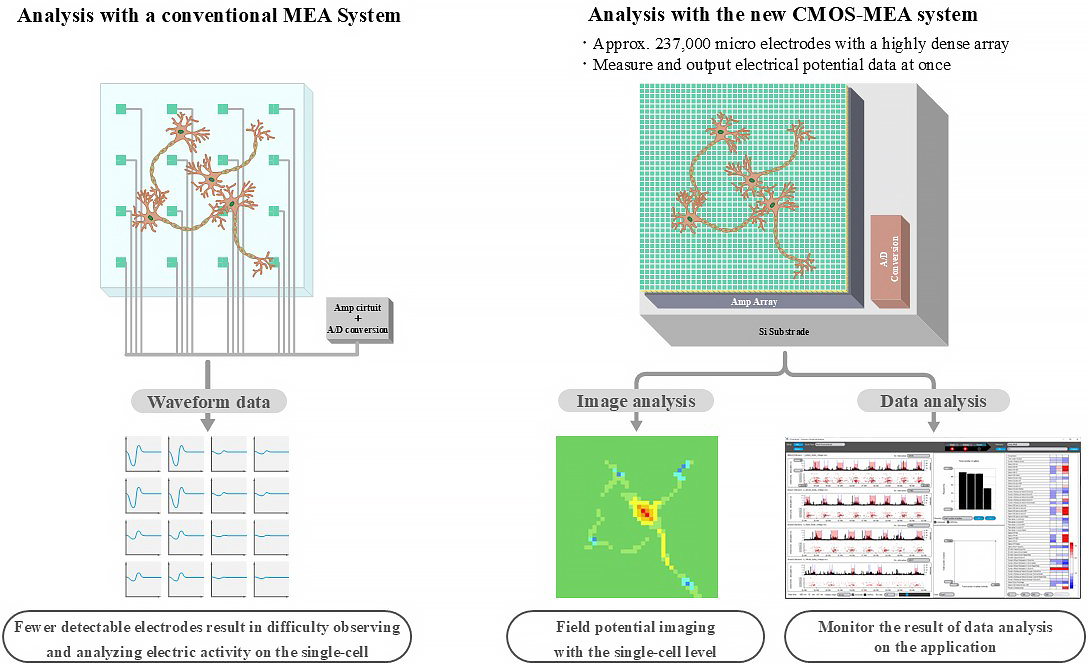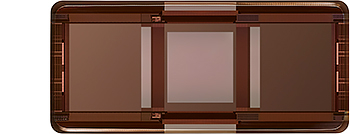
(Left: MEA System Hardware, Right: Application and UI)
Sony, SCREEN and VitroVo to Start Trial Offer of MEA System Capable of Simultaneous Measuring and Recording Data from Approximately 237,000 Electrodes
Contributing to high-definition visualization of cellular activity and supporting research into neuronal and cardiac diseases and drug discovery
Japan — Sony Semiconductor Solutions Corporation (Sony), SCREEN Holdings Co., Ltd. (SCREEN), and VitroVo Inc. (VitroVo) today announced that they have jointly developed and will offer on a trial basis a microelectrode array (MEA) system powered by high-density CMOS-MEA*1 equipped with approximately 237,000 electrodes. Combining Sony’s advanced sensing devices, SCREEN Group’s cellular electrical activity measurement technology, and VitroVo’s MEA-driven compound evaluation and data analysis knowledge, the MEA system makes it possible to measure and record high-density cell activity data which was previously difficult, and to visualize cellular activity in high definition. This innovation is aimed to contribute primarily to neuronal and cardiac disease research and drug discovery.
In the field of drug research and development, improved accuracy in efficacy assessment and safety evaluation in nonclinical testing, and further streamlined development processes are in demand. There have been currently growing needs for the new methods with advanced technologies and microphysiological systems such as organoids, human iPSC- derived nerve cells and cardiomyocytes, which enable the high accurate evaluation of the effects of compounds on a human body without the usage of experimental animal. They can offer a new approach to animal testing which is currently mandatory prior to clinical trials of new drugs. Also, the acquisition of more sophisticated cell data is expected to contribute to disease research initiatives.
The three companies have come together to develop the high-density MEA system with the cooperation of the Tohoku Institute of Technology (Tohtech). Based on cell electrical activity data, the system enables observation of the differences between diseased and healthy cells and the response of cells to compounds on the single cell level. More specifically, Sony’s high-density CMOS-MEA,*1 which is currently in development, and the SCREEN Group’s cellular electrical activity measurement technology were combined to detect extracellular electrical potential with the high-density array of microelectrodes, which is then output as image data. Through this process, users can monitor the cell firing*2, measure and record the reaction. Furthermore, the system is equipped with an algorithm optimized by VitroVo (based on joint research by Sony and Tohtech) for compound evaluation and an analysis software to enable better operability for users. This makes it possible to quickly display analysis results such as cell firing frequency as calculated from electrical potential and image measurement data, on a monitor. These measurement and analysis capabilities enable acquisition of cell activity data with greater density than with conventional methods, allowing users to obtain test results that were difficult with conventional measurement methods.
This system can support research on disease phenotypes based on high-density cellular activity data and the risk assessment or the more efficient efficacy evaluation of compounds for new drugs as alternatives to animal testing. Because the system enables observation of neurons, it will also likely be used in the research and development of new drugs for mental illnesses such as depression and schizophrenia, neurological disorders such as amyotrophic lateral sclerosis (ALS) and Alzheimer’s disease, as well as in basic neuroscience research.
To verify the efficacy of the system and evaluation method as well as promote technical development in the lead-up to commercialization, the three companies will jointly provide the system to corporations and research institutions involved in drug development on a trial base. In addition to SCREEN providing the system, VitroVo will offer support for introducing the system by consulting on cell culture procedures, custom data analysis, and interpreting test results. At the same time, VitroVo will begin offering contract research services to verify the effectiveness of the system. This trial offer will allow the three companies to accelerate system development and market surveys based on feedback from users, with the goal of commercializing MEA systems utilizing CMOS-MEA.
*1 CMOS-MEA: A device that uses complementary metal-oxide-semiconductor technology and a microelectrode array to detect cell electrical activity
*2 Cell firing: The phenomenon in which nerve cells generate action potentials, causing electrical excitation, releasing neurotransmitters, and transmitting information to surrounding nerve cells. Cell firing enables signal transduction in the brain and nervous system.

About CMOS-MEA
- CMOS-MEA is a device capable of measuring cellular electrical activity in real time. A microelectrode array (MEA) in a dense formation on top of the sensor chip measures the electrical potential generated by the influx and outflux of ions associated with cell activity, then processes the signal and outputs it as image data. This technology makes it possible to check the effects of drugs and other compounds on cells and propagation processes using images.
 The CMOS-MEA currently being developed by Sony uses a reduced pitch between electrodes, resulting in a compact design with a highly dense array of approximately 237,000 electrodes. The high-speed A/D conversion and interface technologies that Sony has cultivated while developing image sensors make it possible to read data from all electrodes at once.
The CMOS-MEA currently being developed by Sony uses a reduced pitch between electrodes, resulting in a compact design with a highly dense array of approximately 237,000 electrodes. The high-speed A/D conversion and interface technologies that Sony has cultivated while developing image sensors make it possible to read data from all electrodes at once.
- Joint research between Sony and Tohtech has revealed that CMOS-MEA will enable high-definition cell monitoring that was difficult with conventional technology, and data analysis on the single-cell level. It has also shown promise for applications not only in drug discovery but also in a wide variety of disciplines such as biotechnology, biomedical science, medicine, and pharmacology. The results of their research have also been applied to the development of the system.
Related Publications: |
|
| ・ |
Ikuro Suzuki, Naoki Matsuda, Xiaobo Han, Shuhei Noji, Mikako Shibata, Nami Nagafuku, Yuto Ishibashi, Large-area field potential imaging having single neuron resolution using 236,880 electrodes CMOS-MEA technology |
| ・ | N. Matsuda, N. Nagafuku, K. Matsuda, Y. Ishibashi, T. Taniguchi, Y. Matsushita, N. Miyamoto, T. Yoshinaga, I. Suzuki, Field potential Imaging in human iPSC- derived Cardiomyocytes using UHD-CMOS-MEA. bioRxiv: https://www.biorxiv.org/content/10.1101/2025.03.31.646249v1; DOI: https://doi.org/10.1101/2025.03.31.646249 |
| ・ | H. Takahashi, N. Matsuda, I. Suzuki, Analysis of β rhythm induction in acute brain slices using field potential imaging with ultra-high-density CMOS-based microelectrode array. bioRxiv: https://www.biorxiv.org/content/10.1101/2025.03.30.646248v1; DOI:https://doi.org/10.1101/2025.03.30.646248 |
Roles of each company in system development and trial offer
Sony: Hardware development including provision of the CMOS-MEA sensor
SCREEN: Development of software involved in cellular data measurement and analysis, customer support for trial system offering
VitroVo: Provision of contracted research services using the system, consulting on cultures and analysis upon introducing the system, and development of new utilization and analysis technologies
Contact about this News
Public Relations, Sony Semiconductor Solutions Corporation
semicon.press@sony.com
Public Relations, Corporate Communications Department, SCREEN Holdings Co., Ltd.
nr-info@screen.co.jp
VitroVo, Inc.
contact@vitrovo.co.jp
Information contained in the news release are current on the date of publication, but may be subject to change without notice.